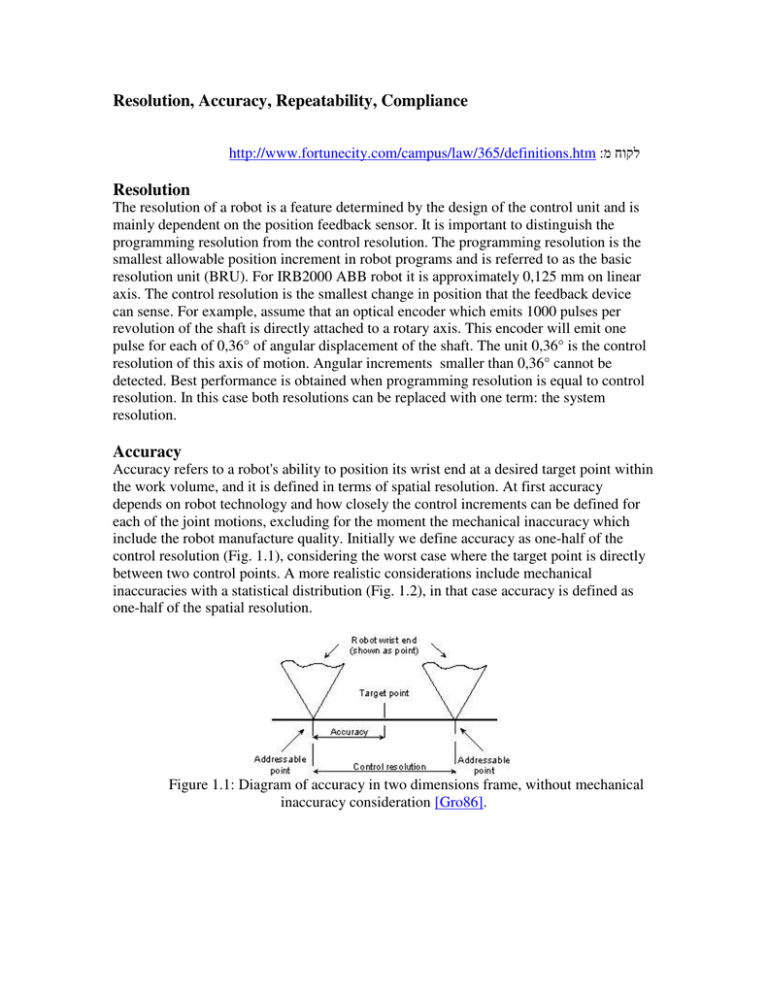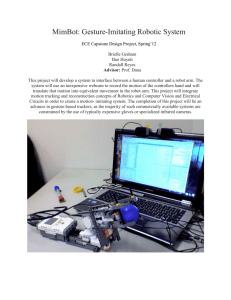Robot Resolution, Accuracy, Repeatability, Compliance
advertisement

Resolution Accuracy, Repeatability, Compliance http://www.fortunecity.com/campus/law/365/definitions.htm Resolution The resolution of a robot is a feature determined by the design of the control unit and is mainly dependent on the position feedback sensor. It is important to distinguish the programming resolution from the control resolution. The programming resolution is the smallest allowable position increment in robot programs and is referred to as the basic resolution unit (BRU). For IRB2000 ABB robot it is approximately 0,125 mm on linear axis. The control resolution is the smallest change in position that the feedback device can sense. For example, assume that an optical encoder which emits 1000 pulses per revolution of the shaft is directly attached to a rotary axis. This encoder will emit one pulse for each of 0,36° of angular displacement of the shaft. The unit 0,36° is the control resolution of this axis of motion. Angular increments smaller than 0,36° cannot be detected. Best performance is obtained when programming resolution is equal to control resolution. In this case both resolutions can be replaced with one term: the system resolution. Accuracy Accuracy refers to a robot's ability to position its wrist end at a desired target point within the work volume, and it is defined in terms of spatial resolution. At first accuracy depends on robot technology and how closely the control increments can be defined for each of the joint motions, excluding for the moment the mechanical inaccuracy which include the robot manufacture quality. Initially we define accuracy as one-half of the control resolution (Fig. 1.1), considering the worst case where the target point is directly between two control points. A more realistic considerations include mechanical inaccuracies with a statistical distribution (Fig. 1.2), in that case accuracy is defined as one-half of the spatial resolution. Figure 1.1: Diagram of accuracy in two dimensions frame, without mechanical inaccuracy consideration [Gro86]. Figure 1.2: Diagram of accuracy and spatial resolution in which mechanical inaccuracies are represented by a statistical distribution [Gro86]. The term accuracy in robotics is often confused with the terms resolution and repeatability. The final accuracy of a robotic system depends on its mechanical inaccuracies, the computer control algorithms, and the system resolution. The mechanical inaccuracies are caused mainly by backlash in the manipulators joints and bending of the links. The backlash exists in gear mechanisms, in leadscrews, and in actuators of hydraulic drives. The minimisation of the link bendings is the main design requirement for the link, as any deflection of the link due to the load at the robot's end causes positional errors. A higher rigidity of the links, however, should not be achieved by a substantial increase in their mass. A larger mass causes an increase in the time response of the arm. Control algorithms might cause position errors due to round-off errors in the computer. Computer round-off errors might be significant if a robot controller uses scaled integer representation of Cartesian and angular coordinates. If the computer uses floating point representation, then the round-off errors will probably be insignificant. Different definitions of robot accuracy exists, for example in Robotics for Engineers [Kor85], system inaccuracy due to resolution is considered to be 1/2 BRU (Basic Resolution Unit). The reason is that displacements smaller than 1 BRU can be neither programmed nor measured and, on the average, they count for 1/2 BRU. A realistic accuracy system is determined in the following relationship: Robot accuracy = ( BRU + mechanical accuracy )/2 Important: The definition currently used is the ISO 9283 definition (ISO / TC 184 / SC 2 / WG 2), it considers errors in 3 dimensions. Figure 1.3 : Errors affecting the robot structure [Naw93] Accuracy is affected also by external factors. As torque moment is becoming more important on the wrist point with the fully extended configuration, accuracy decrease within the work volume, from the closer position of the arm to its base, till positions out of work volume range. The term error map is used to characterise the level of accuracy possessed by the robot as a function of location in the work volume. Accuracy is improved if the motion cycle is restricted to a limited work range, while it decreases if the load being carried by the robot becomes important Position accuracy depends on the position in the workspace envelope. For this reason, it is difficult to do robot off-line programming without using sensors. The sources of position error that affect accuracy can be grouped into four categories: 1) digitisation error, 2) calibration error, 3) deterministic kinematic error, 4) stochastic kinematic error [Ram88]. As the assembly robots axes are often vertically, accuracy is slightly better because it is less affected by external factors and mechanical inaccuracies; but this is not enough to perform some parts mating applications as peg-in-hole without problems. Repeatability Repeatability is a statistical term associated with accuracy, it describes how a point is repeated. If a robot joint is instructed to move by the same angle from a certain point a number of times, all with equal environmental conditions, it will be found that the resultant motions lead to differing displacements (Fig. 1.4). Although a target is always missed by a large margin, if the same error is repeated, then we say that the repeatability is high and the accuracy is poor. Repeatability does not describe the error with respect to absolute coordinates. System repeatability is the positional deviation from the average of displacements. For example, +-0,2 mm indicates that any point might be as much as 0,2 mm beyond or short of the center of the repeatability pattern. Most robot manufacturers provide a numerical value for the repeatability rather than the accuracy of their robots. The reason is that the accuracy depends upon the particular load that the gripper carries. A heavier weight causes larger deflections of the robot links and larger load on the joints, which degrade the accuracy, while the repeatability value, however, is almost independent of the gripper load. The repeatability of robots will usually be better than the accuracy, it is normally measured in hundredths of an inch. Repeatability definition which is currently used is the ISO 9283 definition (ISO / TC 184 / SC 2 / WG 2). Figure 1.4: Example of representation of resolution, accuracy, and repeatability of a robot arm [Kor85]. Compliance The compliance arising out of the slip between object and fingers and from the elasticity of the skin, endows a human operator with extraordinary dexterity for precision assembly. The same compliance enables robot manipulators to perform a variety of manipulation tasks which require fine motion skills (Fig. 2.1). Compliance refers to the displacement of the wrist end in response to a force or a torque exerted against it. A high compliance means that the wrist is displaced a large amount by a relatively small force. Compliance is important because it may reduces the robot precision of movement under load as in the case of robot pressing a tool against a workpart, the reaction force of the part may cause deflection of the manipulator. Figure 2.1: A typical example of parts mating operation. The robot arm compliance allowed the peg to be directed by the hole wall. SCARA robot, which stands for Selectively Compliant Assembly Robot Arm, is particularly designed for assembly tasks. The robot shoulder has elbow joints which rotate around the vertical axes (Fig. 2.2). The configuration provides substantial rigidity for the robot in the vertical direction while allowing for compliance in the horizontal plane which enhance accuracy by a compensation of residual errors (Fig. 2.3). The robot arm has four degrees of freedom with four links and joints, it confers a sufficient work volume for requested assembly applications, and makes it cheaper than full freedom degrees robots. SCARA robots are produced by almost all robots manufacturers and still the more used in assembly cells. Figure 2.2: A four axes IBM SCARA Figure 2.3: Importance of compliance in Peg-inhole applications. robot.



